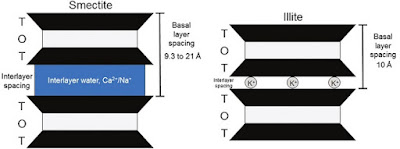 |
| smectite vs. illite |
Back in the earliest days of the internet, long before Insta photos of avocado toast or tweens dying from TikTok challenges, a "master" of UseNet called himself "the Great KIBO," an acronym for "Knowledge In, Bullshit Out." How prescient! because Yirka's post is a classic example of KIBO. Fortunately, he included a link to his source material, so S.G. could see where this dumbassery entered the process. It was not with the three scientists who published the material...
As we noted before, Yirka appears to have satisfactorily answered the questions of what, when, and where. It's in his attempt to transcribe the "how" that Bob fell down on the job. Here are his own words:
"Their theory posits that after a volcano erupted (creating among other things, lithium), a hydrothermal enrichment occurred—magma deep unground pushed its way to the center of what is now the caldera, leading to the formation of the Montana Mountains. As that happened, faults, fissures and fractures were created, allowing lithium to seep up toward the surface. This process also transformed much of the smectite into illite (different forms of clay minerals), which wound up along the southern rim of the basin. That, they conclude, explains why lithium is so abundant there."
Let's unpack that, misstatement by misstatement:
|
- Yirka missed the point: lithium is abundant in claystone deposits throughout the caldera, in part because much of the section is sourced in the ash and other ejecta of the same volcano. The hydrothermal process further enriched smectite deposits as they transitioned to illite with exposure to higher temperatures.
Freelance "journalism" like this is why the Great KIBO was right, and why we still hand out new Dumbass of the Day awards. Feh.
SI - VOLCANOES
No comments:
Post a Comment